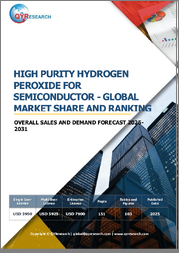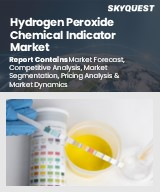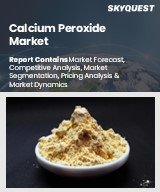
|
시장보고서
상품코드
1718307
과산화벤조일 시장 : 농도 레벨, 형태, 최종사용자, 유통 채널별 - 세계 예측(2025-2030년)Benzoyl Peroxide Market by Concentration Level, Forms, End-User, Distribution Channel - Global Forecast 2025-2030 |
||||||
과산화벤조일 시장은 2024년에는 9억 6,670만 달러로 평가되었으며, 2025년에는 10억 2,035만 달러로 성장하고, CAGR은 5.61%, 2030년에는 13억 4,192만 달러에 달할 것으로 예측됩니다.
| 주요 시장 통계 | |
|---|---|
| 기준 연도 2024년 | 9억 6,670만 달러 |
| 추정 연도 2025년 | 10억 2,035만 달러 |
| 예측 연도 2030년 | 13억 4,192만 달러 |
| CAGR(%) | 5.61% |
과산화벤조일은 오랫동안 다양한 산업에 응용할 수 있는 만능 화합물로 인식되어 왔습니다. 역사적으로 여드름 치료 및 중합 개시제로 널리 사용되어 온 과산화벤조일은 새로운 산업 동향과 기술 발전으로 인해 현재 다시 주목받고 있습니다. 이 시장은 새로운 생산 공정, 진화하는 규제 프레임워크, 지속가능성에 대한 관심 증가에 영향을 받아 수요의 변화를 목격하고 있습니다. 안전과 성능에 대한 소비자의 인식이 높아진 데다 최근 제품 배합의 기술 혁신은 도전과 기회로 가득 찬 역동적인 시장 환경에 기여하고 있습니다. 이 입문적 분석은 벤조일 퍼옥사이드 생산의 품질과 효율성의 기준을 재정의하는 현재의 시장 촉진요인, 위험 요소 및 기회를 탐색함으로써 무대를 마련합니다. 업계가 급격한 변화에 적응하는 과정에서 이해관계자들은 규제의 영향과 진화하는 응용 분야로 인한 복잡성을 극복해야 합니다. 본 분석은 의사결정자에게 정보를 제공할 뿐만 아니라, 시장의 성장 궤도를 뒷받침하는 근본적인 요인을 이해하는 데 도움이 될 수 있도록 안내하고자 합니다.
과산화벤조일 시장 역학에 영향을 미치는 혁신적인 변화
과산화벤조일 분야의 시장 역학은 기술, 규제 환경 및 소비자 기대치가 전례 없는 속도로 진화하면서 혁신적인 변화를 경험하고 있습니다. 화학적 처리 및 제형 기술의 혁신은 보다 정밀한 적용과 제품 성능의 향상을 가능하게 했습니다. 이러한 변화는 지속가능한 생산 방식을 향한 업계 전반의 노력으로 보완되어 생산자와 최종사용자 모두에게 의사결정 과정에서 중요한 요소로 작용하고 있습니다. 이와 함께 규제 기관은 새로운 안전 및 환경 규정 준수 기준을 도입하고 제조 프로토콜을 재정의하고 있습니다. 예를 들어, 기업들은 현재 자동화와 디지털화를 업무에 통합하여 낭비를 줄이고 공정 효율성을 높임으로써 엄격한 품질 및 환경 목표를 달성하고 있습니다. 또한, 디지털 상거래와 소비자 구매 행동의 변화로 인한 유통 환경의 변화는 제품 마케팅 및 판매 방식에도 영향을 미치고 있습니다. 이러한 상황의 변화로 인해 제조업체와 시장 환경은 민첩성을 유지하고, 탄탄한 R&D 이니셔티브에 투자하고, 제품 포지셔닝 전략을 지속적으로 재평가하여 세계 표준과 시장 수요에 부합하는 제품 포지셔닝 전략을 지속적으로 재평가할 것을 요구하고 있습니다.
시장 전략을 추진하기 위한 고급 세분화 분석
과산화벤조일 시장의 세분화 분석은 소비자의 의사결정과 제품 사용 시나리오를 뒷받침하는 중요한 계층을 드러내는데, 한 가지 측면은 농도 수준에 따라 제품이 10%, 2.5%, 5% 등 다양한 강도로 차별화되는 농도 수준입니다. 이러한 농도 기반 평가는 다양한 효능 요건에 대응할 뿐만 아니라 가격 구조와 규제 준수 전략을 형성합니다. 또 다른 중요한 세분화 요소는 물리적 형태이며, 시장은 크게 액체 제형과 분말 제형으로 나뉩니다. 이러한 차별화를 통해 제조업체는 각 제형의 고유한 장점을 활용하여 특정 산업 용도 및 소비자 니즈를 타겟팅할 수 있습니다. 또한, 건축 및 건설, 화학 및 플라스틱 산업, 식품 산업, 제약 및 화장품 부문과 같은 최종사용자 분류는 이 화합물의 광범위한 관련성과 산업 전반에 대한 적응성을 보여줍니다. 마지막으로, 오프라인과 온라인 판매 채널을 구분하여 판매 채널의 세분화도 고려하고 있습니다. 각 세분화는 이해관계자들이 생산, 마케팅, 유통 전략을 미세 조정하여 시장 점유율을 확보하고 타겟 애플리케이션의 성장을 촉진할 수 있도록 명확한 인사이트를 제공합니다.
목차
제1장 서문
제2장 조사 방법
제3장 주요 요약
제4장 시장 개요
제5장 시장 인사이트
- 시장 역학
- 성장 촉진요인
- 성장 억제요인
- 기회
- 해결해야 할 과제
- 시장 세분화 분석
- Porter’s Five Forces 분석
- PESTLE 분석
- 정치
- 경제
- 사회
- 기술
- 법률
- 환경
제6장 과산화벤조일 시장 : 농도 레벨별
- 10%
- 2.5%
- 5%
제7장 과산화벤조일 시장 : 형태별
- 액체
- 분말
제8장 과산화벤조일 시장 : 최종사용자별
- 건축·건설
- 화학·플라스틱 산업
- 식품 업계
- 의약품·화장품
제9장 과산화벤조일 시장 : 유통 채널별
- 오프라인 판매
- 온라인 판매
제10장 아메리카의 과산화벤조일 시장
- 아르헨티나
- 브라질
- 캐나다
- 멕시코
- 미국
제11장 아시아태평양의 과산화벤조일 시장
- 호주
- 중국
- 인도
- 인도네시아
- 일본
- 말레이시아
- 필리핀
- 싱가포르
- 한국
- 대만
- 태국
- 베트남
제12장 유럽, 중동 및 아프리카의 과산화벤조일 시장
- 덴마크
- 이집트
- 핀란드
- 프랑스
- 독일
- 이스라엘
- 이탈리아
- 네덜란드
- 나이지리아
- 노르웨이
- 폴란드
- 카타르
- 러시아
- 사우디아라비아
- 남아프리카공화국
- 스페인
- 스웨덴
- 스위스
- 튀르키예
- 아랍에미리트
- 영국
제13장 경쟁 구도
- 시장 점유율 분석, 2024
- FPNV 포지셔닝 매트릭스, 2024
- 경쟁 시나리오 분석
- 전략 분석과 제안
기업 리스트
- AkzoNobel N.V.
- Anmol Chemical
- Arkema Group
- Arkema S.A.
- Cambrex Corporation.
- Galderma S.A.
- Johnson & Johnson Consumer Inc.
- L'Oreal S.A.
- Lanxess AG
- Merck KGaA
- N Shashikant & Co
- Norac Pharma
- OCEAN PHARMACEUTICAL
- Rochem International Inc
- Sihauli Chemicals Private Limited.
- Spectrum Chemical Mfg. Corp
- SPI Pharma, Inc.
- Unilever PLC
- United Initiators GmbH
- Vizag Chemicals
- Zydus Group.
The Benzoyl Peroxide Market was valued at USD 966.70 million in 2024 and is projected to grow to USD 1,020.35 million in 2025, with a CAGR of 5.61%, reaching USD 1,341.92 million by 2030.
| KEY MARKET STATISTICS | |
|---|---|
| Base Year [2024] | USD 966.70 million |
| Estimated Year [2025] | USD 1,020.35 million |
| Forecast Year [2030] | USD 1,341.92 million |
| CAGR (%) | 5.61% |
Benzoyl peroxide has long been recognized as a versatile compound with applications spanning various industries. Historically known for its extensive use in acne treatments and as a polymerization initiator, this chemical is now witnessing renewed interest due to emerging industrial trends and technological advancements. The market has seen shifts in demand influenced by new production processes, evolving regulatory frameworks, and increasing focus on sustainability. Recent innovations in product formulation, alongside heightened consumer awareness regarding safety and performance, have contributed to a dynamic market environment that is both challenging and full of opportunity. This introductory analysis sets the stage by exploring the current market drivers, risk factors, and opportunities that have redefined the benchmark of quality and efficiency in benzoyl peroxide production. As the industry adapts to rapid changes, stakeholders must navigate through complexities driven by regulatory influences and evolving application domains. The analysis provided herein is intended not only to inform but also to guide decision-makers in understanding the underlying factors that support the market's growth trajectory.
Transformative Shifts Influencing the Benzoyl Peroxide Market Dynamics
Market dynamics in the benzoyl peroxide sector have experienced transformative shifts as technology, regulatory environments, and consumer expectations evolve at an unprecedented pace. Innovations in chemical processing and formulation techniques have allowed for more targeted applications and improved product performance. These changes are complemented by an industry-wide push towards sustainable production practices, which have become a critical component in the decision-making process for both producers and end-users. In parallel, regulatory bodies have introduced new safety and environmental compliance standards that have redefined manufacturing protocols. For instance, companies are now integrating automation and digitization in their operations to reduce waste and enhance process efficiency, thereby meeting strict quality and environmental targets. Furthermore, changing distribution landscapes, intensified by digital commerce and shifts in consumer purchasing behavior, have influenced how products are marketed and sold. This evolving landscape requires manufacturers and marketers to remain agile, invest in robust research and development initiatives, and continuously re-evaluate product positioning strategies to ensure alignment with global standards and market demand.
Nuanced Segmentation Insights Driving Market Strategy
The segmentation analysis in the benzoyl peroxide market reveals critical layers that underscore consumer decision-making and product usage scenarios. One dimension is based on concentration level where products are differentiated across various strengths such as 10%, 2.5%, and 5%. This concentration-based evaluation not only addresses diverse efficacy requirements but also shapes pricing structures and regulatory compliance strategies. Another important segmentation factor is the physical form, with the market broadly categorized into liquid and powder formulations. This differentiation allows manufacturers to target specific industrial applications and consumer needs by leveraging unique benefits inherent to each form. Additionally, the end-user segmentation-which spans Building & Construction, Chemical & Plastics Industry, Food Industry, as well as Pharmaceutical & Cosmetics sectors-illustrates the compound's broad relevance and adaptability across industries. Finally, the analysis also considers the distribution channel segmentation, distinguishing between offline and online sales channels. Each segment offers distinct insights, enabling stakeholders to fine-tune production, marketing, and distribution strategies in order to capture market share and stimulate growth in targeted applications.
Based on Concentration Level, market is studied across 10%, 2.5%, and 5%.
Based on Forms, market is studied across Liquid and Powder.
Based on End-User, market is studied across Building & Construction, Chemical & Plastics Industry, Food Industry, and Pharmaceutical & Cosmetics.
Based on Distribution Channel, market is studied across Offline Sales and Online Sales.
Regional Dynamics Shaping the Benzoyl Peroxide Market
An in-depth review of regional trends reveals unique market behaviors and opportunities in different parts of the world. In the Americas, robust industrial growth combined with stringent regulatory standards has created a stable demand landscape for benzoyl peroxide. Meanwhile, the Europe, Middle East & Africa region is witnessing a blend of mature market dynamics and emerging innovation strategies that continue to fuel product development and competitive differentiation. In the Asia-Pacific region, rapid industrialization, expanding consumer bases, and increasing investment in research and development are driving substantial growth. These geographically diverse market conditions urge companies to adopt localized strategies that address specific regulatory, economic, and cultural nuances. The interplay of these regional insights underscores the need for a global perspective while maintaining agile, region-specific tactics that can efficiently navigate local market challenges and capitalize on emerging opportunities.
Based on Region, market is studied across Americas, Asia-Pacific, and Europe, Middle East & Africa. The Americas is further studied across Argentina, Brazil, Canada, Mexico, and United States. The United States is further studied across California, Florida, Illinois, New York, Ohio, Pennsylvania, and Texas. The Asia-Pacific is further studied across Australia, China, India, Indonesia, Japan, Malaysia, Philippines, Singapore, South Korea, Taiwan, Thailand, and Vietnam. The Europe, Middle East & Africa is further studied across Denmark, Egypt, Finland, France, Germany, Israel, Italy, Netherlands, Nigeria, Norway, Poland, Qatar, Russia, Saudi Arabia, South Africa, Spain, Sweden, Switzerland, Turkey, United Arab Emirates, and United Kingdom.
Key Company Insights and Competitive Landscape
The competitive environment in the benzoyl peroxide market is characterized by the presence of both multinational giants and niche players who continue to influence innovation and market penetration. Key industry contributors such as AkzoNobel N.V., Anmol Chemical, Arkema Group, Arkema S.A., and Cambrex Corporation have leveraged advanced manufacturing techniques and strategic partnerships to enhance their market presence. Firms like Galderma S.A., Johnson & Johnson Consumer Inc., and L'Oreal S.A. have broadened their portfolios by incorporating benzoyl peroxide into diverse therapeutic and industrial applications. Additionally, chemical innovators including Lanxess AG, Merck KGaA, and N Shashikant & Co have focused on refining product efficacy and regulatory compliance. Other notable players such as Norac Pharma, OCEAN PHARMACEUTICAL, Rochem International Inc, and Sihauli Chemicals Private Limited have strategically positioned themselves within growing niches of the market. Companies like Spectrum Chemical Mfg. Corp, SPI Pharma, Inc., Unilever PLC, United Initiators GmbH, Vizag Chemicals, and Zydus Group further contribute to a layered competitive landscape where quality, innovation, and customer-centric strategies dictate market success. These firms have not only demonstrated strong product performance but have also embraced sustainability and digital transformation as core themes for continued growth.
The report delves into recent significant developments in the Benzoyl Peroxide Market, highlighting leading vendors and their innovative profiles. These include AkzoNobel N.V., Anmol Chemical, Arkema Group, Arkema S.A., Cambrex Corporation., Galderma S.A., Johnson & Johnson Consumer Inc., L'Oreal S.A., Lanxess AG, Merck KGaA, N Shashikant & Co, Norac Pharma, OCEAN PHARMACEUTICAL, Rochem International Inc, Sihauli Chemicals Private Limited., Spectrum Chemical Mfg. Corp, SPI Pharma, Inc., Unilever PLC, United Initiators GmbH, Vizag Chemicals, and Zydus Group.. Strategic Recommendations for Market Leaders
Industry leaders looking to fortify their positions in the benzoyl peroxide market must prioritize innovation while balancing compliance with evolving environmental regulations. It is recommended that companies invest in advanced R&D to develop safer and more efficient formulations that cater to both traditional applications and emerging markets. Firms must continually monitor the regulatory landscape to proactively adjust production parameters and ensure adherence to safety standards. Embracing digital transformation is equally critical, as streamlined supply chains and enhanced customer engagement strategies can offer a significant competitive edge. Additionally, companies should consider revisiting their segmentation strategies by leveraging insights from concentration and form-based product differentiation alongside targeted end-user analyses. Expanding capabilities to meet the dual demands of offline and online distribution channels can further optimize market outreach. Collaboration across industry stakeholders, including partnerships with regional distributors and technological innovators, is another vital strategy. Such alliances can provide access to new markets and enhance the overall value proposition while mitigating risks associated with operational disruptions and regulatory shifts.
Conclusive Outlook on Market Trends and Future Prospects
Summing up the current analysis, the benzoyl peroxide market is poised at an intersection of robust traditional demand and evolving innovation-driven growth. The transformative shifts in technology, process efficiency, and regulatory frameworks are paving the way for a more integrated and sustainable industry model. Strategic segmentation based on concentration levels, product forms, end-user diversity, and distribution channels offers a holistic insight into the myriad opportunities available. Meanwhile, regional market nuances, spanning the Americas, Europe, Middle East & Africa, and Asia-Pacific, accentuate the complex yet promising global landscape. Key industry players continue to drive value through a mix of technological prowess and market adaptability, underscoring the competitive nature of the sector. As companies navigate these diverse trends, a proactive approach toward innovation, strategic partnerships, and informed resource allocation will be paramount in maintaining market leadership. The consolidation of these insights signals that proactive investment in R&D and an agile operational mindset remain the cornerstones for future growth and sustainable success in this competitive market.
Table of Contents
1. Preface
- 1.1. Objectives of the Study
- 1.2. Market Segmentation & Coverage
- 1.3. Years Considered for the Study
- 1.4. Currency & Pricing
- 1.5. Language
- 1.6. Stakeholders
2. Research Methodology
- 2.1. Define: Research Objective
- 2.2. Determine: Research Design
- 2.3. Prepare: Research Instrument
- 2.4. Collect: Data Source
- 2.5. Analyze: Data Interpretation
- 2.6. Formulate: Data Verification
- 2.7. Publish: Research Report
- 2.8. Repeat: Report Update
3. Executive Summary
4. Market Overview
5. Market Insights
- 5.1. Market Dynamics
- 5.1.1. Drivers
- 5.1.1.1. Advancements in formulation and delivery systems enhancing the efficacy and skin compatibility of benzoyl peroxide products
- 5.1.1.2. Growing prevalence of acne among adolescents and young adults driving demand for effective acne treatment solutions
- 5.1.2. Restraints
- 5.1.2.1. Potential for skin irritation and sensitivity limiting broader consumer adoption of benzoyl peroxide-based products
- 5.1.3. Opportunities
- 5.1.3.1. Increasing digital media influence and social media awareness expanding market reach and consumer engagement for benzoyl peroxide products
- 5.1.3.2. Rising consumer preference for natural, organic, and eco-friendly skincare solutions promoting innovation in benzoyl peroxide formulations
- 5.1.4. Challenges
- 5.1.4.1. Navigating strict regulatory requirements and compliance standards across multiple global markets for benzoyl peroxide products
- 5.1.1. Drivers
- 5.2. Market Segmentation Analysis
- 5.2.1. Forms: Significance of liquid benzoyl peroxide in skincare and industrial applications
- 5.2.2. End-User: Growing applications of benzoyl peroxide in building & construction for polymerization and material development
- 5.3. Porter's Five Forces Analysis
- 5.3.1. Threat of New Entrants
- 5.3.2. Threat of Substitutes
- 5.3.3. Bargaining Power of Customers
- 5.3.4. Bargaining Power of Suppliers
- 5.3.5. Industry Rivalry
- 5.4. PESTLE Analysis
- 5.4.1. Political
- 5.4.2. Economic
- 5.4.3. Social
- 5.4.4. Technological
- 5.4.5. Legal
- 5.4.6. Environmental
6. Benzoyl Peroxide Market, by Concentration Level
- 6.1. Introduction
- 6.2. 10%
- 6.3. 2.5%
- 6.4. 5%
7. Benzoyl Peroxide Market, by Forms
- 7.1. Introduction
- 7.2. Liquid
- 7.3. Powder
8. Benzoyl Peroxide Market, by End-User
- 8.1. Introduction
- 8.2. Building & Construction
- 8.3. Chemical & Plastics Industry
- 8.4. Food Industry
- 8.5. Pharmaceutical & Cosmetics
9. Benzoyl Peroxide Market, by Distribution Channel
- 9.1. Introduction
- 9.2. Offline Sales
- 9.3. Online Sales
10. Americas Benzoyl Peroxide Market
- 10.1. Introduction
- 10.2. Argentina
- 10.3. Brazil
- 10.4. Canada
- 10.5. Mexico
- 10.6. United States
11. Asia-Pacific Benzoyl Peroxide Market
- 11.1. Introduction
- 11.2. Australia
- 11.3. China
- 11.4. India
- 11.5. Indonesia
- 11.6. Japan
- 11.7. Malaysia
- 11.8. Philippines
- 11.9. Singapore
- 11.10. South Korea
- 11.11. Taiwan
- 11.12. Thailand
- 11.13. Vietnam
12. Europe, Middle East & Africa Benzoyl Peroxide Market
- 12.1. Introduction
- 12.2. Denmark
- 12.3. Egypt
- 12.4. Finland
- 12.5. France
- 12.6. Germany
- 12.7. Israel
- 12.8. Italy
- 12.9. Netherlands
- 12.10. Nigeria
- 12.11. Norway
- 12.12. Poland
- 12.13. Qatar
- 12.14. Russia
- 12.15. Saudi Arabia
- 12.16. South Africa
- 12.17. Spain
- 12.18. Sweden
- 12.19. Switzerland
- 12.20. Turkey
- 12.21. United Arab Emirates
- 12.22. United Kingdom
13. Competitive Landscape
- 13.1. Market Share Analysis, 2024
- 13.2. FPNV Positioning Matrix, 2024
- 13.3. Competitive Scenario Analysis
- 13.3.1. Sol-Gel Technologies Partners with Shenzhen Beimei for TWYNEO Distribution in Greater China and Israel
- 13.3.2. PanOxyl acne foaming wash by Crown Laboratories achieves top dermatologist recommendation
- 13.3.3. Bausch Health launches innovative triple-combination acne treatment, CABTREO, to strengthen dermatology market position
- 13.4. Strategy Analysis & Recommendation
Companies Mentioned
- 1. AkzoNobel N.V.
- 2. Anmol Chemical
- 3. Arkema Group
- 4. Arkema S.A.
- 5. Cambrex Corporation.
- 6. Galderma S.A.
- 7. Johnson & Johnson Consumer Inc.
- 8. L'Oreal S.A.
- 9. Lanxess AG
- 10. Merck KGaA
- 11. N Shashikant & Co
- 12. Norac Pharma
- 13. OCEAN PHARMACEUTICAL
- 14. Rochem International Inc
- 15. Sihauli Chemicals Private Limited.
- 16. Spectrum Chemical Mfg. Corp
- 17. SPI Pharma, Inc.
- 18. Unilever PLC
- 19. United Initiators GmbH
- 20. Vizag Chemicals
- 21. Zydus Group.



















